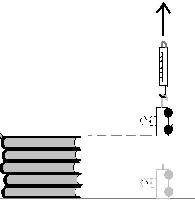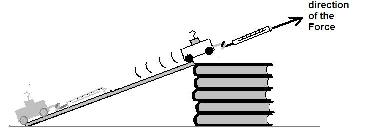
the weights down,
it supplies energy
to run the clock
Energy

|
| As gravity pulls the weights down, it supplies energy to run the clock |
|---|
The definition we will start with is that energy is what you have to add to lift something up. To give energy to something, you push on it and it has to move in the direction you are pushing. The energy transferred is calculated by
Energy transferred = force x distance
where the "distance" is how far the object moves while the force is being exerted. The energy transferred this way is sometimes called "work." For example, to lift a 70 N (16 lb) bowling ball from the floor to waist level (0.8 m) requires 56 Joules. Rolling the ball very slowly on a level floor takes very little energy, because there is no force being exerted in the direction the ball is moving.
The relationship between force, energy, and distance is valid for all kinds of forces; it is not special to problems involving weight.
Conservation of Energy
The many forms of energy are related by the requirement that when we change one form into another, the total energy of the universe stays constant. We say "energy is conserved." Giving energy to one thing means less energy somewhere else: the energy accounting books have to account for every Joule. Money also has this aspect, that there is a bookkeeping, so we might say physicists are interested in energy the same way that economists are interested in money. But energy differs from money in that there is no inflation, no taxes, and no interest on the energy bank balance: the total amount of energy stays exactly the same.
In one activity of this unit, you compared several ways to move a rolling cart from the bottom of a hill to the top. One way is to lift the cart straight upwards (Figure 1). To do this, you exerted an upwards force (the weight W of the cart) while the cart moved the height H. Another way is to pull the cart up an incline (Figure 2). Now you exert a different, smaller force F (which you can measure) while the card travels the larger distance D.

|

|
| Figure 1 | Figure 2 |
|---|
Energy transferred = Weight x Height = Force x Distance
Decreasing the steepness of the ramp decreases the force but increases the distance; the energy required is the same in all cases.
Because we are calculating the energy you transferred to the cart, we use the force you exerted on the cart, which points in the direction indicated on the diagram.
In the other activity of this unit, you used a lever to raise an object. This lets us raise the object with a smaller force than its weight (or at least it would, if we had a weightless lever!), but it doesn't change the energy needed to lift it, because we have to move the end of the lever farther.
These examples show how we can transform forces, so that by exerting a small force in one place, a large force is exerted in another. The part of the device where we exert the small force moves a large distance, while the large force acts over a smaller distance: the energy we put in is the same as the amount that comes out.
Potential energy
The energy needed to move the cart from the table to the top of the stack of books is the same, no matter whether we lift the cart vertically or move up an incline. This leads to the idea of a kind of energy that depends only on position. It allows us to say that a book on a high shelf has more energy than a book on the floor, without discussing how we get it from one place to another. This kind of energy is called potential energy. It is energy that we invested to lift the book to the shelf; we will get all of the energy back when the book falls off of the shelf. There are other ways to store energy (stretching a spring, for example), and these can also be called potential energy. If we want to be clear, we call the energy stored by lifting an object gravitational potential energy.
Physicists are very interested in energy, because the conservation of energy is a very strong constraint on what can happen in a physical process. For example, when we throw a ball we give it some energy. As the ball rises higher, more and more of its energy is in the form of potential energy; at a certain height, all of the energy is in potential energy, and this limits how high the ball can go.
Many Kinds of Energy
The concept of energy and the idea that energy is conserved is a relatively recent discovery in physics. Part of the reason is that there are many forms of energy, which are measured in very different ways. Chemical reactions release energy; electricity transfers energy from one part of a circuit to another; sound and light carry energy; we add energy to an object when we bend it or warm it or lift it. Another reason that the conservation of energy was hard to discover is that some forms of energy are relatively hard to detect. In particular, a small rise in temperature represents a large addition of energy.
However, conservation of energy is also a very familiar thing. We have to eat; batteries go dead; a car runs out of gas; plants will not grow without sunlight; we have to pay the gas company and the electric company for supplying energy. These examples have in common that energy is coming out of something, so we know that sooner or later we will have to put energy back in if it is to continue to function.